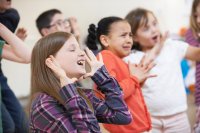Getting Creative With SEL
How to incorporate creative expression and movement in the classroom while building social and emotional learning skills.
Finding opportunities to integrate creative expression and movement throughout the school day is a priority in the development of the whole child. Leveraging creative expression and movement to build core social and emotional learning (SEL) competencies, however, is a relatively new concept.
Creative expression can be achieved through a variety of modalities and provides opportunities to identify, process, and express emotions. Movement can be integrated into the school day in ways that are appropriate for almost any grade level, and movement forms neural connections that help us better understand our own emotions and build empathy for others.
Encouraging Creative Expression
Being creative is an inherently vulnerable process. In order to authentically build SEL competencies through creative expression, teachers need to strive to create a safe space, provide time, and open doors for validation.
- Creating a safe and supportive classroom environment: Through a consensual conversation about class norms, teachers work to continually develop a space where students feel comfortable sharing emotions and know that their feelings will be respected, setting the stage for creative expression.
- Providing time: Set up daily opportunities to build SEL skills to make emotion identification, expression, and management a daily practice. When a person prioritizes physical health, they don’t eat healthy or exercise for one day; rather, they develop an ongoing routine. Strengthening social and emotional well-being is no different.
- Opening the doors for validation: Give students time to share and acknowledge each other’s emotions. Help students develop affirming statements they use with one another, such as, “I see you, I hear you, and now I better understand you.” This will help build empathy and foster a positive classroom culture. Writing and drawing can be nice additions here, as both are outlets that help us identify and process emotions and experiences. Some teachers also use journaling as an emotion management strategy.
Classroom Activities to Bring Creative Expression to Life
There are a number of ways that creative expression and movement can be incorporated to teach and build SEL skills.
Human tableaux. This involves students creating an image that’s frozen in time, similar to a snapshot. For this exercise, students work in groups to create images in response to particular prompts. One student in the group is the director and the others are actors. The director places students into a still image that answers the prompt from their perspective. Prompts could include: “What will success look like for you this school year?” and “What is a current challenge you’re facing?” You can even use this exercise to have students describe what they did over a school break.
One word, plus movement: Open the school day by asking each student to share one word that describes how they’re currently feeling and pair it with a movement. Take this a step further by having all classmates mirror the movement back to show validation. Or have students try on different emotions by using their faces and bodies to depict what happiness, anger, stress, pride, surprise, sadness, etc. might look and feel like.
Gratitude practice: Ask students to close their eyes and think about something they’re grateful for. Then tell them to think of a movement they could do that describes how that gratitude makes them feel. Then have them open their eyes and give them time to share their movements with one another. You can do this exercise with other emotions as well—optimism, worry, frustration, joy.
Leveraging technology helps to provide this safe and structured time and guide students through experiential, creative exercises. Here are two videos that walk students through creative exercises:
- Emotional ABCs (elementary grade levels)
- Word Core (secondary grade levels)
Incorporating creative expression and movement in the classroom might seem intimidating at first. Providing students with a structured space to engage in creative expression can help them feel more comfortable. And presenting them with clear models and examples that describe what these activities will look like can also encourage them to actively participate.
